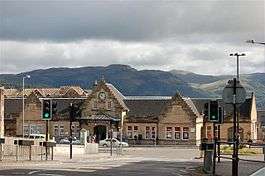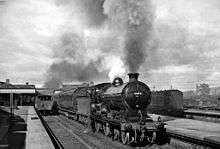Stirling railway station, Scotland
| Stirling | |
|---|---|
 | |
| Location | |
| Place | Stirling |
| Local authority | Stirling |
| Coordinates | 56°07′12″N 3°56′06″W / 56.1201°N 3.9351°WCoordinates: 56°07′12″N 3°56′06″W / 56.1201°N 3.9351°W |
| Grid reference | NS797935 |
| Operations | |
| Station code | STG |
| Managed by | Abellio ScotRail |
| Number of platforms | 7 |
|
Live arrivals/departures, station information and onward connections from National Rail Enquiries | |
| Annual rail passenger usage* | |
| 2010/11 |
|
| 2011/12 |
|
| 2012/13 |
|
| 2013/14 |
|
| 2014/15 |
|
| History | |
| 1848 | Opened |
| 1913 | Rebuilt[1] |
| National Rail – UK railway stations | |
| * Annual estimated passenger usage based on sales of tickets in stated financial year(s) which end or originate at Stirling from Office of Rail and Road statistics. Methodology may vary year on year. | |
|
| |
Stirling railway station is a railway station located in Stirling, Scotland. It is located on the former Caledonian Railway main line between Glasgow and Perth. It is the junction for the branch line to Alloa and Dunfermline via Kincardine and is also served by trains on the Edinburgh to Dunblane Line and long distance services to Dundee & Aberdeen and to Inverness via the Highland Main Line.
History

Stirling was first connected to the Scottish Central Railway in 1848. Lines were subsequently opened by the Stirling and Dunfermline Railway in 1853, and by the Forth and Clyde Junction Railway to Balloch Central three years later. Through services to/from the Callander and Oban Railway also served the station from 1870. The current station buildings were opened in 1916 following a major rebuild by the Caledonian Railway. They have undergone several refurbishments (with minor layout changes), the most recent change being the installation of lifts to enable better access to the footbridge linking Platform 2 with Platforms 3 to 8. The line to Balloch lost its passenger services in 1934 and closed as a through route in 1942, although the section from Stirling to Port of Menteith remained open for freight until 1959. The main line from Stirling to Dunfermline was not scheduled for closure under the Beeching Axe, but it was nevertheless closed in 1968. It has since been partly reopened as far as Alloa (see below). Oban services via the C&O line ended with the Beeching cuts in 1965, and the main terminus in Glasgow for services from Stirling changed from the former C.R. station at Buchanan Street to Queen Street the following year.
A Motorail service ran between London and Stirling until 1989.[2]
An exhibition of the station over the last 100 years is planned for 2013.[3]
Description
The station building was constructed in 1915 by James Miller, and is listed by Historic Environment Scotland as a Category A listed building.[4]
In 2008, the travel centre was refurbished to improve disabled access, including power-assisted entrance doors, a wheelchair-accessible counter, and improved customer information systems. In 2009, a shelter was erected on Platforms 9 and 10, and LED display boards replaced the CRT screens, including new displays for Platforms 9 and 10 and the bay Platforms 7 and 8. (Up to c.1988, a large flip-dot display was located above the main concourse; this was removed and the space filled in with a large "Welcome to Stirling Station" sign.) From December 2009, automated announcements were provided, replacing the manual announcements made from the supervisor's office on Platform 3. In 2013, a new public address system was installed.[5]
The station houses a Neighbourhood Policing Team (NPT) from the British Transport Police. Currently two officers work from Stirling and cover Stirling, Alloa, Bridge of Allan, Camelon, Dunblane, Falkirk High, Falkirk Grahamston and Larbert.
The Stirling Area Command of the Forth Valley Division of Police Scotland cover the territorial area the Stirling NPT cover and will assist when the BTP officers are not available.
Services

Trains operate north to Dunblane (three trains per hour), to Perth, Dundee and Aberdeen (hourly), Inverness (four trains per day), south west to Glasgow Queen Street (three trains per hour), and east to Edinburgh Waverley (half-hourly).[6] The service to Alloa and Dunfermine was withdrawn in October 1968, but the reopening of the Stirling-Alloa-Kincardine rail link partially restored that service with an hourly service from Glasgow to Alloa as an extension of the Croy Line services. This utilises the existing DMU from Glasgow, which previously spent considerable time in one of the bay platforms at Stirling with engines idling, but now utilises the layover time to make the return trip to & from Alloa.
Most services are operated by Abellio ScotRail although there is one train a day operated by Virgin Trains East Coast to London Kings Cross and one in the opposite direction to Inverness. As of December 2015 an extra service by Virgin Trains East Coast runs an early morning service between Stirling and London Kings Cross. The Caledonian Sleeper between Inverness & London Euston also calls. The station has nine platforms, though they are ordered 2 to 10. The site of Platform 1 is now occupied by a car park; the platforms were not renumbered. The bay platforms at the north end of the station (Platforms 4 and 5) survive but are not available to passenger trains. The bay platforms at the south end of the station (Platforms 7 and 8) are not normally used for weekday services, but the first services of the day use trains that have been stabled there overnight and they have been fitted with passenger information displays.
A major Scottish area timetable recast in 2018 backed by Transport Scotland will see improved journey times from Stirling to both Edinburgh & Glasgow and more frequent services to Gleneagles, Dundee, Perth & Inverness.[7] The lines from Glasgow to Alloa & Polmont to Dunblane are also due to be resignalled & electrified by 2018 as part of the rolling modernisation work associated with the Edinburgh to Glasgow Improvement Programme.
| Preceding station | |
Following station | ||
|---|---|---|---|---|
| Falkirk Grahamston | Virgin Trains East Coast East Coast Main Line |
Dunblane or Terminus | ||
| Larbert | Abellio ScotRail Edinburgh–Dunblane Line |
Bridge of Allan | ||
| Dunblane | Caledonian Sleeper Highland Caledonian Sleeper |
Falkirk Grahamston (Southbound only) | ||
| Edinburgh Waverley (Northbound only) |
Caledonian Sleeper Highland Caledonian Sleeper |
Dunblane | ||
| Larbert | Abellio ScotRail Croy Line |
Alloa | ||
| Abellio ScotRail Croy Line |
Bridge of Allan | |||
| Glasgow Queen Street | Abellio ScotRail Glasgow to Aberdeen Line Highland Main Line |
Gleneagles | ||
| Historical railways | ||||
| Bannockburn Line open; Station closed |
Caledonian Railway Scottish Central Railway |
Bridge of Allan Line and Station open | ||
| Terminus | North British Railway Stirling and Dunfermline Railway |
Causewayhead Line open; station closed | ||
| Terminus | North British Railway Forth and Clyde Junction Railway |
Gargunnock Line and station closed | ||
References
- ↑ Railscot - Stirling
- ↑ "BR Motorail service pulls out of Stirling". The Herald. Glasgow. 8 February 1989. Retrieved 15 September 2016.
- ↑ "Help celebrate station's history". Stirling Observer.
- ↑ "Stirling Railway Station including platform buildings, footbridges, middle signal boxes, north signal box and semaphore signals". Historic Environment Scotland. Retrieved 15 September 2016.
- ↑ "Planning Application Summary 12/00157/LBC Replacement of public address system including installation of new speakers on and within station buildings, canopy etc.". Stirling Council.
- ↑ GB eNRT May 2016 Edition, Tables 229 & 230
- ↑ "‘Rail revolution’ means 200 more services and 20,000 more seats for Scots passengers"Transport Scotland press release 15 March 2016, Retrieved 18 August 2016
- Butt, R. V. J. (1995). The Directory of Railway Stations: details every public and private passenger station, halt, platform and stopping place, past and present (1st ed.). Sparkford: Patrick Stephens Ltd. ISBN 1-8526-0508-1. OCLC 60251199.
- Jowett, Alan (March 1989). Jowett's Railway Atlas of Great Britain and Ireland: From Pre-Grouping to the Present Day (1st ed.). Sparkford: Patrick Stephens Ltd. ISBN 1-8526-0086-1. OCLC 22311137.
- McCutcheon, Bob (1999). Stirling. Tempus Publishing. ISBN 0-7524-1853-X.
External links
| Wikimedia Commons has media related to Stirling railway station (Scotland). |